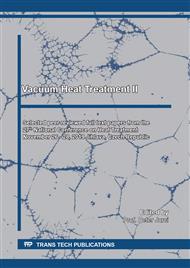[1]
Bryson, W. E.: Cryogenics. Hanser Gardner Publications, Cincinnati, USA, (1999).
Google Scholar
[2]
Hájek, J. a kol., Kryogenní zpracování brzdových kotoučů [online]. 2018 [cit. 2019-02-28]. Available at:https://www.autodilycardo.cz/db/downloads/38_Kryogenni_zpracovani_ brzdovych_kotoucu_eci.pdf.
Google Scholar
[3]
Kříž, A., Hájek, J., Chocholatý, O., Průcha, V. Effect of deep cryogenic treatment on properties of aluminium bronze. In European Conference on Heat Treatment 2016. 2016. ISBN: 978-80-904462-9-8.
Google Scholar
[4]
Carlson, E. Cold treating and cryogenic treatment of steel. ASM International, ASM Handbook.1991, 4: 203-206.
Google Scholar
[5]
Nižňanská, J.: Vliv kryogenního zpracování na vlastnosti nástrojových ocelí pro práci za tepla, diploma thesis. Department of Material Science and Technology, Faculty of Mechanical Engineering, University of West Bohemia, (2014).
Google Scholar
[6]
Huang, J. Y., et al. Microstructure of cryogenic treated M2 tool steel. Materials Science and Engineering: A, 2003, 339.1-2: 241-244.
DOI: 10.1016/s0921-5093(02)00165-x
Google Scholar
[7]
Stratton, P.F.: In.: Proc. of the 1st Int. Conf. on Heat Treatment and Surf. Engng. of Tools and Dies, Pula, Croatia, 8.-11.6.2005,11.
Google Scholar
[8]
Vadilek, K. and R. Rudramoorthy. Performance analysis of cryogenically treated coated carbide inserts. The International Journal of Advanced Manufacturing Technology [online]. 2009, 42(3-4), 222-232 [cit. 2020-01-30].
DOI: 10.1007/s00170-008-1597-z
Google Scholar
[9]
Gill, Simranpreet Singh, Harpreet Singh, Rupinder Singh a Jagdev Singh. Flank Wear and Machining Performance of Cryogenically Treated Tungsten Carbide Inserts. Materials and Manufacturing Processes [online]. 2011, 26(11), 1430-1441 [cit. 2020-01-30].
DOI: 10.1080/10426914.2011.557128
Google Scholar
[10]
Yong, Jiang a Chen Ding. Effect of cryogenic treatment on WC–Co cemented carbides. Materials Science and Engineering: A [online]. 2011, 528(3), 1735-1739 [cit. 2020-01-30].
DOI: 10.1016/j.msea.2010.11.009
Google Scholar
[11]
Yong, A.Y.L., K.H.W. Seah a M. Rahman. Performance evaluation of cryogenically treated tungsten carbide tools in turning. International Journal of Machine Tools and Manufacture [online]. 2006, 46(15), 2051-2056 [cit. 2020-01-30].
DOI: 10.1016/j.ijmachtools.2006.01.002
Google Scholar
[12]
Kalsi, N.S., Sehgal, R. & Sharma, V.S. Effect of tempering after cryogenic treatment of tungsten carbide–cobalt bounded inserts. Bull Mater Sci 37, 327–335 (2014). Available at: https://doi.org/10.1007/s12034-014-0634-9.
DOI: 10.1007/s12034-014-0634-9
Google Scholar
[13]
Editor-in-chief Vinod K. Sarin a Luis Lanes edited by Daniele Mari. (2014). Comprehensive hard materials, Volume 1, Hardmetals. Elsevier.ISBN 9780080965284.
Google Scholar
[14]
Yong, A. Y. L., K. H. W. Seah a M. Rahman. Performance of cryogenically treated tungsten carbide tools in milling operations. The International Journal of Advanced Manufacturing Technology [online]. 2007, 32(7-8), 638-643 [cit. 2020-01-31].
DOI: 10.1007/s00170-005-0379-0
Google Scholar
[15]
Akincioglu, Sıtkı, Hasan Gokkaya and İlyas Uygur. A review of cryogenic treatment on cutting tools. The International Journal of Advanced Manufacturing Technology [online]. 2015, 78(9-12), 1609-1627 [cit. 2020-01-31].
DOI: 10.1007/s00170-014-6755-x
Google Scholar
[16]
Ruperinder, s. Enhancement of Tool Material Machining Characteristics with Cryogenic Treatment: A Review. Proceedings of the 2010 International Conference on Industrial Engineering and Operations Management Dhaka, Bangladesh, January 9-10, 2010. Available at: http://www.iieom.org/paper/Final%20Paper%20for%20PDF/164%20Rupinder%20Singh%20Khalsa.pdf.
Google Scholar
[17]
Padmakumar, M., D. Dinakaran and J. Guruprasath. Characterization of cryogenically treated cemented carbide. Integrated Ferroelectrics [online]. 2017, 185(1), 65-72 [cit. 2020-01-31].
DOI: 10.1080/10584587.2017.1370340
Google Scholar
[18]
Ishida, K and T Nishizawa. The C-Co (Carbon-Cobalt) system. Journal of Phase Equilibria [online]. 1991, 12(4), 417-424 [cit. 2020-01-31].
DOI: 10.1007/bf02645959
Google Scholar
[19]
Thakur, Dinesh, B. Ramamoorthy and L. Vijayaraghavan. Influence of different post treatments on tungsten carbide–cobalt inserts. Materials Letters [online]. 2008, 62(28), 4403-4406 [cit. 2020-02-03].
DOI: 10.1016/j.matlet.2008.07.043
Google Scholar
[20]
Zhang, Hejia, Liqing Chen, Jing Sun, Wenguang Wang a Quanzhao Wang. An investigation of cobalt phase structure in WC–Co cemented carbides before and after deep cryogenic treatment. International Journal of Refractory Metals and Hard Materials [online]. 2015, 51, 201-206 [cit. 2020-02-03].
DOI: 10.1016/j.ijrmhm.2015.04.007
Google Scholar
[21]
Wear parts – a complete catalogue [online]. CERATIZIT S.A., 2015 [cit. 2020-01-30]. Available at: https://www.ceratizit.com/uploads/tx_extproduct//files/GD_KT_PRO-0272-0915_SCS_ABS_V1.pdf.
Google Scholar
[22]
ASTM B 657-92 Standard Guide for Metallographic Identification of Microstructure in Cemented Carbides. [online] Astm.org. Available at: https://www.astm.org/Standards/B657.htm [Accessed 2 Apr. 2019].
Google Scholar
[23]
ISO 4499-1, Hardmetals — Metallographic determination of microstructure — Part 4: Characterisation of porosity, carbon defects and eta-phase content.
DOI: 10.3403/30275876u
Google Scholar
[24]
ASTM G99 2016 Standard Test Method for Wear Testing with a Pin-on-Disk Apparatus. [online] Astm.org. Available at: https://www.astm.org/ DATABASE.CART/HISTORICAL/G99-05R16.htm [Accessed 28 Aug. 2019].
Google Scholar
[25]
ISO 3878: 1983 Hardmetals — Vickers Hardness. Geneva, Switzerland, (1983).
Google Scholar
[26]
ISO 28079: 2009 Hardmetals — Palmqvist Toughness. Geneva, Switzerland, (2009).
Google Scholar


